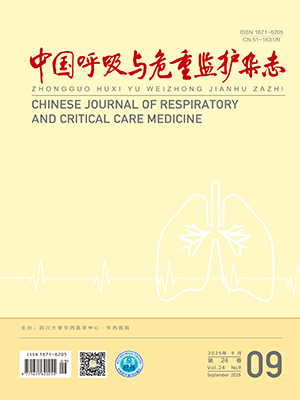Objective To observe the clinical characteristics of asthma patients with chronic duration stage combined with small airway dysfunction (SAD), and analyze the influencing factors of SAD and the cardiopulmonary function of such patients under exercise. Methods The patients with chronic duration of asthma admitted to Nanjing Affiliated Hospital of Traditional Chinese Medicine from July 2022 to April 2024 were divided into a SAD group and a non-SAD group according to the lung function results. Clinical data and relevant data of cardiopulmonary exercise test (CPET) were collected, the clinical data and cardiopulmonary function between the two groups were compared. The influencing factors of SAD were explored by multivariate logistic regression analysis. Results A total of 102 patients with chronic asthma duration, 59 (57.8%) in the SAD group and 43 (42.2%) in the non-SAD group were included. In the SAD group, age, body masss index, asthma duration were greater than those in the non-SAD group, and SAD score was lower than that in the non-SAD group; the proportion of patients with acute onset of asthma, history of smoking, allergic rhinitis, and asthma control test score were higher than those in the non-SAD group, the exhaled nitric oxide level of SAD group was higher than that in the non-SAD group, and the conventional lung function level was lower than that in the non-SAD group (P<0.05). CPET showed that the VE/VCO2 slope and CO2 equivalent in the SAD group were higher than those in the non-SAD group, and the peak kg oxygen uptake, peak heart rate, and respiratory reserve were lower than those in the non-SAD group, showing a statistically significant difference (P<0.05). Multivariate logistic analysis showed that age, increase of carbon dioxide equivalent at peak exercise, acute onset of asthma and allergic rhinitis were independent risk factors for SAD, and the increase of peak expiratory flow rate was the protective factor (P<0.05). Conclusions SAD in chronic persistent asthma is affected by various factors such as age, acute asthma attacks and history of allergic rhinitis. CPET indicates that patients with asthma who also have SAD have their cardiopulmonary function and aerobic capacity impaired to some extent.
Citation:
HUANG Nanxin, LIU Lijun, ZHAO Shaoqian, LIU Lanying, WANG Hesheng. Analysis of factors affecting small airway dysfunction and evaluation of cardiopulmonary function in patients with chronic duration of asthma. Chinese Journal of Respiratory and Critical Care Medicine, 2025, 24(7): 473-480. doi: 10.7507/1671-6205.202410033
Copy
Copyright © the editorial department of Chinese Journal of Respiratory and Critical Care Medicine of West China Medical Publisher. All rights reserved
| 1. |
|
| 2. |
|
| 3. |
|
| 4. |
Abdo M, Trinkmann F, Kirsten AM, et al. Small airway dysfunction links asthma severity with physical activity and symptom control. J Allergy Clin Immunol Pract, 2021, 9(9): 3359-3368. e1.
|
| 5. |
|
| 6. |
|
| 7. |
|
| 8. |
|
| 9. |
|
| 10. |
|
| 11. |
|
| 12. |
|
| 13. |
|
| 14. |
|
| 15. |
Xiao D, Chen Z, Wu S, et al. Prevalence and risk factors of small airway dysfunction, and association with smoking, in China: findings from a national cross-sectional study. Lancet Respir Med, 2020, 8(11): 1081-1093.
|
| 16. |
|
| 17. |
|
| 18. |
|
| 19. |
|
| 20. |
|
| 21. |
|
| 22. |
|
| 23. |
|
| 24. |
|
| 25. |
|
| 26. |
|
| 27. |
|
| 28. |
|
| 29. |
|
| 30. |
|
| 31. |
|
| 32. |
|
| 33. |
|
| 34. |
Cocchiarella L, Anderson G. American Medical Association: guides to the evaluation of permanent impairment. 5th ed. Chicago: American Medical Association, 2000. 107.
|
| 35. |
|
| 36. |
|
| 37. |
|
| 38. |
|
| 39. |
|
| 40. |
|
| 41. |
|
- 1.
- 2.
- 3.
- 4. Abdo M, Trinkmann F, Kirsten AM, et al. Small airway dysfunction links asthma severity with physical activity and symptom control. J Allergy Clin Immunol Pract, 2021, 9(9): 3359-3368. e1.
- 5.
- 6.
- 7.
- 8.
- 9.
- 10.
- 11.
- 12.
- 13.
- 14.
- 15. Xiao D, Chen Z, Wu S, et al. Prevalence and risk factors of small airway dysfunction, and association with smoking, in China: findings from a national cross-sectional study. Lancet Respir Med, 2020, 8(11): 1081-1093.
- 16.
- 17.
- 18.
- 19.
- 20.
- 21.
- 22.
- 23.
- 24.
- 25.
- 26.
- 27.
- 28.
- 29.
- 30.
- 31.
- 32.
- 33.
- 34. Cocchiarella L, Anderson G. American Medical Association: guides to the evaluation of permanent impairment. 5th ed. Chicago: American Medical Association, 2000. 107.
- 35.
- 36.
- 37.
- 38.
- 39.
- 40.
- 41.




